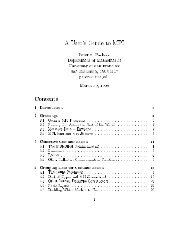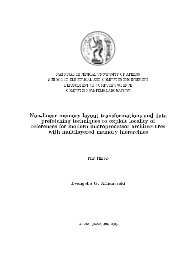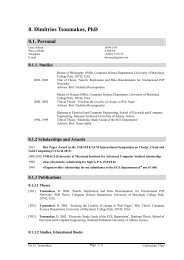Fast and Cost-Effective Online Load-Balancing in - Computing ...
Fast and Cost-Effective Online Load-Balancing in - Computing ...
Fast and Cost-Effective Online Load-Balancing in - Computing ...
Create successful ePaper yourself
Turn your PDF publications into a flip-book with our unique Google optimized e-Paper software.
KONSTANTINOU ET AL.: FAST AND COST-EFFECTIVE ONLINE LOAD-BALANCING IN DISTRIBUTED RANGE-QUERIABLE SYSTEMS 1363<br />
layer. Each bucket conta<strong>in</strong>s a number of ordered items <strong>and</strong><br />
each server may have several buckets. Dur<strong>in</strong>g balanc<strong>in</strong>g<br />
procedures, overloaded nodes move buckets to their<br />
immediate neighbors (similar to a NIX operation). They<br />
address skewed data distributions with a list of free nodes<br />
which can migrate <strong>in</strong> an area to absorb excess load. The<br />
ma<strong>in</strong> drawback of this scheme is the requirement of a list of<br />
free nodes: This luxury cannot be considered trivial <strong>in</strong><br />
actual deployments. In Mercury [17], prob<strong>in</strong>g <strong>and</strong> node<br />
migration is used to solve load-balanc<strong>in</strong>g problems. Nodes<br />
use a r<strong>and</strong>om sampl<strong>in</strong>g procedure with probe messages to<br />
calculate the average network load. When their load is<br />
above or below the average network load, they <strong>in</strong>itiate<br />
balanc<strong>in</strong>g actions. The authors state that their loadbalanc<strong>in</strong>g<br />
scheme is similar to IB [1]: their only difference<br />
is that they m<strong>in</strong>imize flood<strong>in</strong>g dur<strong>in</strong>g prob<strong>in</strong>g as they<br />
perform a clever <strong>and</strong> selective way of dissem<strong>in</strong>at<strong>in</strong>g load<br />
<strong>in</strong>formation. Similar to Mercury is the HiGLOB framework<br />
[18]: each node ma<strong>in</strong>ta<strong>in</strong>s a list of load <strong>in</strong>formation about<br />
nonoverlapp<strong>in</strong>g regions of the key space, <strong>and</strong> if it detects<br />
imbalances, it performs load exchanges follow<strong>in</strong>g the IB<br />
paradigm. In Armada [14], load-balanc<strong>in</strong>g is performed<br />
with a hash function responsible for plac<strong>in</strong>g items <strong>in</strong>to<br />
nodes that knows <strong>in</strong> advance the distribution of items <strong>in</strong> the<br />
ID space. Armada can h<strong>and</strong>le only static workloads, unlike<br />
NIXMIG’s ability to deal with dynamic workloads. Shen<br />
<strong>and</strong> Xu [19], [20] ma<strong>in</strong>ta<strong>in</strong> match<strong>in</strong>gs of overloaded to<br />
underloaded peers: balanc<strong>in</strong>g is performed by mov<strong>in</strong>g<br />
“hot” items <strong>and</strong> plac<strong>in</strong>g doubly l<strong>in</strong>ked po<strong>in</strong>ters both to the<br />
source (overloaded peer) <strong>and</strong> the dest<strong>in</strong>ation (underloaded<br />
peer) of the moved item. The drawback of this method is<br />
that dur<strong>in</strong>g lookups, the overloaded peer will still be<br />
contacted, as it is still responsible for this “hot” item. In<br />
chordal graphs [21], balanc<strong>in</strong>g is performed by a process<br />
called “free drift<strong>in</strong>g” which is actually a NIX operation that<br />
has the disadvantages described <strong>in</strong> Section 5.1.<br />
Node virtualization approaches. The idea of virtual<br />
servers for load-balanc<strong>in</strong>g <strong>in</strong> peer-to-peer systems was<br />
<strong>in</strong>itially proposed <strong>in</strong> CFS [9]. Based on this idea, Rao et al.<br />
[10] proposed three load-balanc<strong>in</strong>g algorithms (One to One,<br />
One to Many, <strong>and</strong> Many to Many) which were extended by<br />
Surana et al. [11] for heterogeneous peer-to-peer systems<br />
with churn. In the first case, an overloaded node contacts<br />
one node at r<strong>and</strong>om (as <strong>in</strong> the work of Karger <strong>and</strong> Ruhl [1])<br />
while <strong>in</strong> the second case it contacts numerous nodes before<br />
it takes a balanc<strong>in</strong>g decision. The third case is similar to the<br />
approach used by Ganesan et al. [15]: a distributed<br />
directory with load <strong>in</strong>formation is ma<strong>in</strong>ta<strong>in</strong>ed <strong>and</strong> contacted<br />
by overloaded peers before any balanc<strong>in</strong>g decision is<br />
taken. Zhu <strong>and</strong> Hu [12] also build <strong>and</strong> ma<strong>in</strong>ta<strong>in</strong> a<br />
distributed load directory <strong>in</strong> the form of a k-ary tree<br />
structure that is stored <strong>in</strong> the overlay. This directory is used<br />
by nodes to detect load imbalances <strong>and</strong> to f<strong>in</strong>d suitable<br />
overloaded-underloaded node pairs. Chen <strong>and</strong> Tsai [13] use<br />
the general assignment problem (a particular case of a l<strong>in</strong>ear<br />
programm<strong>in</strong>g problem) to assign virtual to actual nodes:<br />
they make an <strong>in</strong>itial estimation us<strong>in</strong>g the ant system<br />
heuristic which afterwards is ref<strong>in</strong>ed us<strong>in</strong>g the descent<br />
local search algorithm. This procedure is iteratively applied<br />
until a solution is reached. In Armada [14], the authors use<br />
virtual servers for balanc<strong>in</strong>g purposes but they do not<br />
provide details about their specific implementation.<br />
7 CONCLUSIONS<br />
In this paper, we evaluate the performance <strong>in</strong> terms of<br />
b<strong>and</strong>width cost <strong>and</strong> convergence speed of balanc<strong>in</strong>g rangequeriable<br />
data structures us<strong>in</strong>g successive item exchanges<br />
<strong>and</strong> node migrations. Our theoretical analysis <strong>and</strong> extensive<br />
experimental results show that none of these methods by<br />
itself is capable of efficiently balanc<strong>in</strong>g arbitrary workloads:<br />
Neighbor item exchanges are expensive <strong>in</strong> terms of item<br />
transfers <strong>and</strong> slow <strong>in</strong> terms of convergence speed, whereas<br />
node migrations are fast but costly <strong>in</strong> terms of message<br />
exchange. Our method, NIXMIG, is a hybrid approach that<br />
adaptively decides the appropriate balanc<strong>in</strong>g action <strong>and</strong><br />
provably converges to a balanced state. <strong>Load</strong> moves <strong>in</strong> a<br />
“wave-like” fashion until it is absorbed by underloaded<br />
nodes, while node migration is triggered only when<br />
necessary. Our results show that NIXMIG can be three<br />
times faster, while requir<strong>in</strong>g only one sixth <strong>and</strong> one third of<br />
message <strong>and</strong> item exchanges, respectively, compared to an<br />
exist<strong>in</strong>g load-balanc<strong>in</strong>g algorithm proposed by Karger <strong>and</strong><br />
Ruhl [1] to br<strong>in</strong>g the system <strong>in</strong> a balanced state under a<br />
variety of skewed, dynamic, <strong>and</strong> realistic workloads.<br />
REFERENCES<br />
[1] D.R. Karger <strong>and</strong> M. Ruhl, “Simple Efficient <strong>Load</strong>-<strong>Balanc<strong>in</strong>g</strong><br />
Algorithms for Peer-to-Peer Systems,” Theory of Comput<strong>in</strong>g<br />
Systems, vol. 39, pp. 787-804, Nov. 2006.<br />
[2] M. Cha, H. Kwak, P. Rodriguez, Y. Ahn, <strong>and</strong> S. Moon, “I Tube,<br />
You Tube, Everybody Tubes: Analyz<strong>in</strong>g the World’s Largest User<br />
Generated Content Video System,” Proc. Seventh ACM SIGCOMM<br />
Conf. Internet Measurement, 2007.<br />
[3] S. Sen <strong>and</strong> J. Wong, “Analyz<strong>in</strong>g Peer-to-Peer Traffic Across Large<br />
Networks,” Proc. ACM SIGCOMM Internet Measurements Workshop,<br />
2002.<br />
[4] J. Jung, B. Krishnamurthy, <strong>and</strong> M. Rab<strong>in</strong>ovich, “Flash Crowds <strong>and</strong><br />
Denial of Service Attacks: Characterization <strong>and</strong> Implications for<br />
CDNs <strong>and</strong> Web Sites,” Proc. Int’l Conf. World Wide Web (WWW),<br />
2002.<br />
[5] Y. Vigfusson, A. Silberste<strong>in</strong>, B.F. Cooper, <strong>and</strong> R. Fonseca,<br />
“Adaptively Paralleliz<strong>in</strong>g Distributed Range Queries,” Proc. Int’l<br />
Conf. Very Large Data Bases (VLDB), 2009.<br />
[6] B. Knutsson, H. Lu, W. Xu, <strong>and</strong> B. Hopk<strong>in</strong>s, “Peer-to-Peer Support<br />
for Massively Multiplayer Games,” Proc. IEEE INFOCOM, 2004.<br />
[7] Q. Luo <strong>and</strong> J.F. Naughton, “Form-Based Proxy Cach<strong>in</strong>g for<br />
Database-Backed Web Sites,” Proc. Int’l Conf. Very Large Data Bases<br />
(VLDB), pp. 191-200, 2001.<br />
[8] S.Y. Lee, T.W. L<strong>in</strong>g, <strong>and</strong> H.-G. Li, “Hierarchical Compact Cube for<br />
Range-Max Queries,” Proc. Int’l Conf. Very Large Data Bases<br />
(VLDB), pp. 232-241, 2000.<br />
[9] F. Dabek, M.F. Kaashoek, D. Karger, R. Morris, <strong>and</strong> I. Stoica,<br />
“Wide-Area Cooperative Storage with CFS,” ACM SIGOPS<br />
Operat<strong>in</strong>g Systems Rev., vol. 35, no. 5, pp. 202-215, 2001.<br />
[10] A. Rao, K. Lakshm<strong>in</strong>arayanan, S. Surana, R. Karp, <strong>and</strong> I. Stoica,<br />
“<strong>Load</strong> <strong>Balanc<strong>in</strong>g</strong> <strong>in</strong> Structured P2P Systems,” Proc. Second Int’l<br />
Workshop Peer-to-Peer Systems (IPTPS), pp. 68-79, 2003.<br />
[11] S. Surana, B. Godfrey, K. Lakshm<strong>in</strong>arayanan, R. Karp, <strong>and</strong> I.<br />
Stoica, “<strong>Load</strong> <strong>Balanc<strong>in</strong>g</strong> <strong>in</strong> Dynamic Structured Peer-to-Peer<br />
Systems,” Performance Evaluation, vol. 63, no. 3, pp. 217-240, 2006.<br />
[12] Y. Zhu <strong>and</strong> Y. Hu, “Efficient, Proximity-Aware <strong>Load</strong> <strong>Balanc<strong>in</strong>g</strong> for<br />
DHT-Based P2P Systems,” IEEE Trans. Parallel <strong>and</strong> Distributed<br />
Systems, vol. 16, no. 4, pp. 349-361, Apr. 2005.<br />
[13] C. Chen <strong>and</strong> K. Tsai, “The Server Reassignment Problem for <strong>Load</strong><br />
<strong>Balanc<strong>in</strong>g</strong> <strong>in</strong> Structured P2P Systems,” IEEE Trans. Parallel <strong>and</strong><br />
Distributed Systems, vol. 19, no. 2, pp. 234-246, Feb. 2008.<br />
[14] D. Li, J. Cao, X. Lu, <strong>and</strong> K. Chen, “Efficient Range Query<br />
Process<strong>in</strong>g <strong>in</strong> Peer-to-Peer Systems,” IEEE Trans. Knowledge <strong>and</strong><br />
Data Eng., vol. 21, no. 1, pp. 78-91, Jan. 2009.<br />
[15] P. Ganesan, M. Bawa, <strong>and</strong> H. Garcia-Mol<strong>in</strong>a, “<strong>Onl<strong>in</strong>e</strong> <strong>Balanc<strong>in</strong>g</strong> of<br />
Range-Partitioned Data with Applications to Peer-to-Peer Systems,”<br />
Proc. Int’l Conf. Very Large Data Bases (VLDB), pp. 444-455,<br />
2004.











